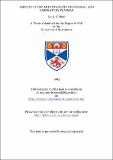Aspects of the MHD stability of coronal and laboratory plasmas
Abstract
The magnetohydrodynamic (MHD) model is a simple mathematical model that treats a plasma as a perfectly conducting fluid acted upon by magnetic and pressure-driven forces. Many instabilities in plasmas can be predicted using this model. In this Thesis, aspects of the linear stability of solar and laboratory plasmas are studied using the MHD model. Firstly, we investigate the thermal instability of coronal plasmas with line-tied magnetic fields and with anisotropical heat conduction, using an analytical analysis which concentrates on isobaric perturbations, and a time-dependent numerical code. We find that including perpendicular thermal conduction means that condensations are restricted to a narrow layer around the region where the local isobaric growth rate is largest and that, while the growth rate of the thermal mode is largely unaffected by perpendicular thermal conduction, this may be an important factor in determining the lengthscale for the width of condensations. Secondly, the effect of a finitely conducting wall on the linear stability of Spheromak and Reversed Field Finch equilibria is investigated. We find growth rates for the modes that are present because of the finite resistivity of the wall, which grow proportionally to the "long" time constant of the wall. Finally, we apply a tractable method, derived by De Bruyne (1990), for investigating the stability of 2-D line-tied magnetic fields, to cylindrically symmetric spheromak equilibria. The method involves the solution of two sets of ordinary differential equations, integrated along the field lines, which give necessary and sufficient conditions for stability. The role of plasma pressure and of the width of the entrance region are investigated.
Type
Thesis, PhD Doctor of Philosophy
Collections
Items in the St Andrews Research Repository are protected by copyright, with all rights reserved, unless otherwise indicated.

